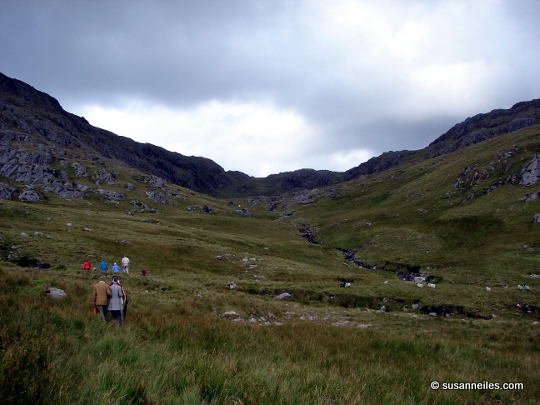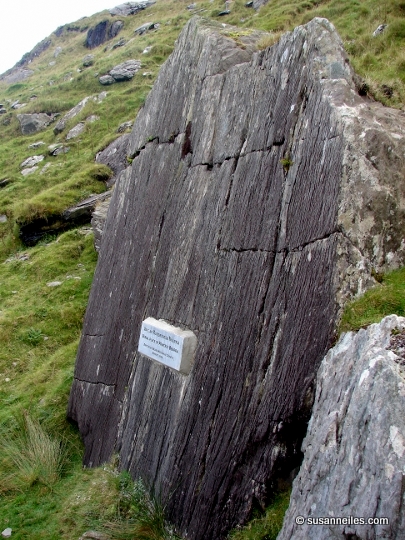Firstly, I would like to take the time to thank all of you who were concerned about my absence from the blog. The last several weeks have been incredibly busy (dizzying)! Art, business commitments, creative pursuits, and serious family health issues have kept me away from the computer. Everything is fine now and I’m eager to get going again. Your kind letters, queries and comments were truly appreciated.
On August 31st, 2008, I was delighted to accompany the Beara Historical Society
on a hike into the hills between the Maulin and Knocknagree Mountains. The purpose of the journey was to attend the unveiling of a very special memorial stone dedicated to the resting place of Princess Beara, after whom the Beara Peninsula was named.
 The day threatened rain, but the skies withheld their bounty until after the ceremony. The uphill hike didn’t look too daunting, but distances can be deceiving in this terrain. I know I’ve mentioned this before in my Hill Walking post, but always remember how important it is to be prepared! The above picture was taken several minutes into the hike and we’d still a long, long way to go. If you look carefully at the picture above you will see a small flat spot at the middle/top of the hill. If you continued traveling over that spot you would end up overlooking the magical Glenbeg Lake.
The day threatened rain, but the skies withheld their bounty until after the ceremony. The uphill hike didn’t look too daunting, but distances can be deceiving in this terrain. I know I’ve mentioned this before in my Hill Walking post, but always remember how important it is to be prepared! The above picture was taken several minutes into the hike and we’d still a long, long way to go. If you look carefully at the picture above you will see a small flat spot at the middle/top of the hill. If you continued traveling over that spot you would end up overlooking the magical Glenbeg Lake.
 We followed well used sheep trails up into the hills. Evidence of famine habitations, ancient potato fields and turf cutting were almost entirely reclaimed by nature. The picture above shows evidence of turf cutting. Do you see the water shimmering in the front left corner? Don’t be fooled by puddles when hiking. That little bit of water could be ankle deep, or up to your waist! Like I said, distances and height/depth perception can be deceiving in this terrain. Those bog cutaways in the distance were actually the height of a man. (or taller!)
We followed well used sheep trails up into the hills. Evidence of famine habitations, ancient potato fields and turf cutting were almost entirely reclaimed by nature. The picture above shows evidence of turf cutting. Do you see the water shimmering in the front left corner? Don’t be fooled by puddles when hiking. That little bit of water could be ankle deep, or up to your waist! Like I said, distances and height/depth perception can be deceiving in this terrain. Those bog cutaways in the distance were actually the height of a man. (or taller!)
 The hikers seemed full of anticipation and felt the importance of this journey for someone who has touched the hearts of many through history and myth. When we reached the stone at the top of the valley we could understand why Princess Beara’s husband,Owen Mór, had chosen this beautiful, peaceful landscape for his beloved’s final resting place. When we looked back down the paths we had followed, our collective breath was taken away by the sheer beauty of the area.
The hikers seemed full of anticipation and felt the importance of this journey for someone who has touched the hearts of many through history and myth. When we reached the stone at the top of the valley we could understand why Princess Beara’s husband,Owen Mór, had chosen this beautiful, peaceful landscape for his beloved’s final resting place. When we looked back down the paths we had followed, our collective breath was taken away by the sheer beauty of the area.
 The unveiling of the plaque was done with great tenderness and respect. Connie Murphy (chairman of the Society) outlined the story of Princess Beara. I’ve copied it here for you to enjoy:
The unveiling of the plaque was done with great tenderness and respect. Connie Murphy (chairman of the Society) outlined the story of Princess Beara. I’ve copied it here for you to enjoy:
“In the early centuries AD, Conn Céad Cathach (Con of the hundred battles) fought a fierce battle against Owen Mór, King of Ireland at Cloch Barraige. Owen was badly injured in the battle. Those of his followers who survived took him to Inis Greaghraighe (now known as Bere Island) as a safe place for him to recover. There, the fairy Eadaoin took him to her grianán (bower) where she nursed him back to full health. Nowadays, this place is known as Greenane.
Owen and his followers then sailed southwards until they reached Spain. There he met and married Beara, daughter of the King of Castille.
Later Owen, Beara and a large army sailed from Spain and landed in Greenane. Owen took his wife to the highest hill on the island and looking across the harbour he named the island and the whole peninsula Beara in honour of his wife. Rossmacowen, Kilmacowen and Buaile Owen most likely are named after Owen Mór and his son. According to local tradition Owen’s wife, Princess Beara, died and was buried in Ballard Commons in the remote and peaceful valley between Maulin and Knocknagree Mountains.”
 A gentleman named John Green unveiled the plaque and recounted how the story of Princess Beara’s resting place has been in his family (O’Sullivan Green) for generations. A poem about Princess Beara had been passed down through his family as an oral tradition. To our delight he wrote the poem down for his son to recite. The young man was kind enough to allow me to copy it down for the blog so that I may share it with you. The poem is as follows:
A gentleman named John Green unveiled the plaque and recounted how the story of Princess Beara’s resting place has been in his family (O’Sullivan Green) for generations. A poem about Princess Beara had been passed down through his family as an oral tradition. To our delight he wrote the poem down for his son to recite. The young man was kind enough to allow me to copy it down for the blog so that I may share it with you. The poem is as follows:
Queen Bealach Bodhrai was buried near Knocknagree
All her jewels were buried there
She married a chief that died with grief
In the Parish of Kilmackowen
 Shared reminices, conversation, music and song were all woven seamlessly into the memorial ceremony. If you would like to learn more about the event and the participants, please visit the Past Talks page on the Beara Historical Society’s website.
Shared reminices, conversation, music and song were all woven seamlessly into the memorial ceremony. If you would like to learn more about the event and the participants, please visit the Past Talks page on the Beara Historical Society’s website.
The hike downhill was absolutely lovely. With the landscape unfurling below us and the sun shining on our backs, it was a fitting end to a beautiful day.





Thank you for this…love your blog. The pictures are always so beautiful.Glad to hear all is well one againBlessing be with you and yours!
great photos! looks like a nice place for spellwork!
Hi. Nice to find I have a blogging “neighbour” too. Lovely post. And knowing the area, I can confirm its inspirational effect on people.
Sitting at the office reading your words and looking at the photo’s gives one pause.You are almost forced to look inside and find out if how you are living your life has meaning in the big picture of things.Keep writing and believing – then the soul will never be lost
It appears you’ve gone silent again. I hope all is OK, and that you’ll soon be posting your beautiful images again.
I want to say that Beara wasn´t a castilian princess, She was a daughter of the King of Galicia.Like many legends that we have in commond with irish legends, this is one. She left the port of Brigantium ( A Coruña )for be married with a irish chieftain.
Yes, you can read this in the book “The spanish second armada” written by Michael J. Carroll, from Bantry, in page 7…saúdos e viva GALICIA…Ireland & Galicia the Celtic connection!!
Pingback: Éadaoin Inari Byrne | The Ring of Beara Blog